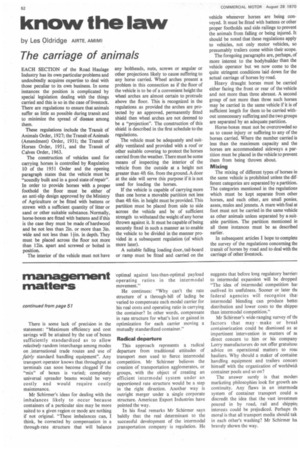know the law
Page 54

If you've noticed an error in this article please click here to report it so we can fix it.
by Les Oldridge AIRTE, AMIMI
The carriage of animals
EACH SECTION of the Road Haulage Industry has its own particular problems and undoubtedly acquires expertise to deal with those peculiar to its own business. In some instances the position is complicated by special legislation dealing with the things carried and this is so in the case of livestock. There are regulations to ensure that animals suffer as little as possible during transit and to minimize the spread of disease among them.
These regulations include the Transit of Animals Order, 1927; the Transit of Animals (Amendment) Order, 1931; the Transit of Horses Order, 1951, and the Transit of Calves Order, 1963.
The construction of vehicles used for carrying horses is controlled by Regulation 10 of the 1951 Order and the opening paragraph states that the vehicle must be "soundly built and in a good state of repair". In order to provide horses with a proper foothold the floor must be either of an anti-slip design approved by the Ministry of Agriculture or be fitted with battens or strewn with a sufficient quantity of litter or sand or other suitable substance. Normally, horse-boxes are fitted with battens and if this is the case they must be made of hardwood and be not less than 2in. or more than 3in. wide and not less than l4in. in depth. They must be placed across the floor not more than 12in. apart and screwed or bolted in position.
The interior of the vehicle must not have any boltheads, nuts, screws or angular or other projections likely to cause suffering to any horse carried. Wheel arches present a problem in this connection as if the floor of the vehicle is to be of a convenient height the wheel arches are almost certain to protrude above the floor. This is recognized in the regulations as provided the arches are protected by an approved, permanently fitted shield then wheel arches are not deemed to be a "projection". The construction of this shield is described in the first schedule to the regulations.
The vehicle must be adequately and suitably ventilated and provided with a roof or other suitable covering to protect the horses carried from the weather. There must be some means of inspecting the interior of the vehicle from the outside at a height not greater than Mt 6in. from the ground. A door at the side will serve this purpose if it is not used for loading the horses.
If the vehicle is capable of carrying more than one horse a movable partition not less than 4ft 6in. in height must be provided. This partition must be placed from side to side across the vehicle and be of sufficient strength to withstand the weight of any horse thrown against it. It must be capable of being securely fixed in such a manner as to enable the vehicle to be divided in the manner provided in a subsequent regulation (of which more later).
A suitable falling loading door, tail-board or ramp must be fitted and carried on the vehicle whenever horses are being conveyed. It must be fitted with battens or other proper footholds and side railings to prevent the animals from falling or being injured. It should be noted that these regulations apply to vehicles, not only motor vehicles, so presumably trailers come within their scope.
The foregoing paragraphs are, perhaps, of more interest to the bodybuilder than the vehicle operator but we now come to the quite stringent conditions laid down for the actual carriage of horses by road.
Heavy draught horses must be carried either facing the front or rear of the vehicle and not more than three abreast. A second group of not more than three such horses may be carried in the same vehicle if it is of sufficient length for them to be carried without unnecessary suffering and the two groups are separated by an adequate partition.
Horse-boxes must not be overcrowded so as to cause injury or suffering to any of the horses carried. Where the number carried is less than the maximum capacity and the horses are accommodated sideways a partition must be placed in the vehicle to prevent them from being thrown about.
Mixing
The mixing of different types of horses in the same vehicle is prohibited unless the different categories are separated by a partition. The categories mentioned in the regulations which must be kept separate from other horses, and each other, are small ponies. asses, mules and jennets. A mare with foal at foot must not be carried in the same vehicle as other animals unless separated by a suitable partition. The partition mentioned in all these instances must be as described earlier.
In subsequent articles I hope to complete the survey of the regulations concerning the transit of horses by road and to deal with the carriage of other livestock.
































































































